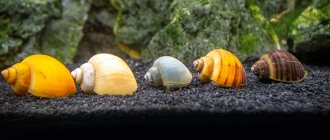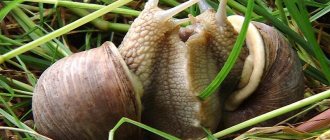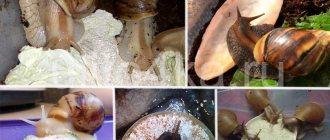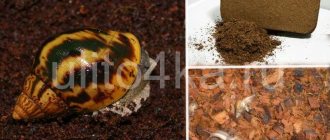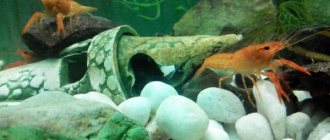The African snail's diet should be varied from an early age. Firstly, this will help the snail grow and develop properly. Secondly, if its diet consists of only 2-3 types of products (favorite food), and it may not be at hand for various reasons, and you decide to feed the mollusk with food unknown to it. Achatina will begin to refuse to eat foods unfamiliar to her, so supplement her menu daily with different vegetables, herbs and fruits. Be sure to read the article about the care and maintenance of small Achatina Here
Caring for Achatina snails
Caring for Achatina snails at home is very simple and does not require significant expenses. You will be interested in reading the article if you want to have a pet and don’t know where to choose, how to care for and feed it.
Such a pet will not create much trouble for the owner
Who would have thought that a French delicacy or field pest would become a pet. Achatina are smart mollusks that can remember their owners and are harmless in communication with small children and adults. Thanks to its simple and easy care, minimal costs, and the ability to go without feeding for a long time, Achatina is an ideal pet. More details in our article.
Most lovers of this type of mollusk are convinced that their pets are very loyal to their owners and do not like to communicate with strangers again. Keeping and caring for Achatina snails is quite simple; they do not require a lot of time, effort and, most importantly, money. African snails belong to the Archatina family; there are many varieties of them. In their homeland they are considered pests; in a short period of time, one large individual can destroy a reed bush. In our area, “huge” snails are a variety of pets.
Achitins are one of the quietest and calmest household residents.
Before purchasing an Achatina, you should prepare all the “conveniences” for it; there are not so many of them. Only special conditions will help the land mollusk lead an active way of life, for such creatures.
How to keep Achatina snails at home
Achatina are the largest land mollusks and can grow up to 30 cm in length. With proper handling and care they can live up to 9 years, the average life cycle is about 6 years. They are quite funny creatures, despite their pedigree, they are smart, they remember the situation and their owners. They often give preference to their favorite corner in the terrarium, which they choose independently.
Large snails do not create noise or unpleasant odor
In order for the Achatina snail to live well and long, its maintenance at home should be as follows:
- Choosing a terrarium. You need to decide on the volume and material from which the new house will be made before you purchase the mollusk. One individual should require from 10 to 20 liters, so the “housing” should be spacious, preferably transparent with ventilation and a heavy lid. The terrarium should be closed at all times, as your pet may crawl out and it will not be easy to find it.
- Lighting is an equally important detail; it should not be very bright, as Achatina can go blind. Her visual apparatus is very sensitive, because... located on the antennae.
- The soil for Achatina snails is selected to be soft and loose, without sharp and small particles that can injure the pet’s delicate body or damage the shell. It is best to use coconut flakes, and soil is prohibited as it contains fertilizers and sawdust, which have sharp edges. The thickness of the flooring should be the size of a snail’s house so that it can freely burrow into it.
- An important point is the temperature, both in the room and in the house itself. African Achatina love a warm climate in which they actively move; if the temperature drops below 24 degrees, they may hibernate or slow down when moving, become lethargic and apathetic.
- Although these snails are not aquatic creatures, the humidity in their home must be constant. You can place a small container of water in the terrarium, which should be heavy so that Achatina cannot turn it over. Or you can constantly wet the walls of the house and the soil, and also bathe the pet itself. When the air is dry, the snail will often hide in its shell.
- You need to clean the terrarium weekly, but change the substrate as it gets dirty.
A glass aquarium or a plastic box can become a home for snails
Proper care will ensure your pets have a long life and create comfortable conditions for reproduction or solitary existence. A livestock specialist can tell you in more detail how to keep Achatina snails at home.
You may be interested in: Features of the French Bulldog breed
How long do Achatina snails live at home?
With the correct content of Achatina, their life expectancy can be 6 years. If you look after them more carefully, constantly feed them, treat them, give them vitamins, maintain the temperature and cleanliness in the terrarium, you can live up to 9 years. In captivity, their lifespan is about 5 years, or maybe less, since these land animals are considered terrible pests and easily destroy entire fields with crops, so in many countries they are actively exterminated.
It is necessary to place soil at the bottom
Now you know how long Achatina snails live at home, everything directly depends on the quality of their maintenance, i.e. it's completely up to you.
What do Achatina snails eat at home?
Achatina must be fed strictly with products from the permissible list
Many lovers of exotic animals, including land mollusks, are interested in the question of what do Achatina snails eat at home? You don’t have to worry too much about this, since they are quite omnivorous. Young animals should be fed daily, but individuals older than 6 months should be fed at intervals of several days.
Pet owners are given the following in their diet:
- Fruits and vegetables, zucchini, cucumbers, pumpkin, lettuce and cabbage leaves, apples, bananas and even watermelon rinds are suitable.
- It is imperative to give crushed chalk and egg shells, which are rich in calcium, which is necessary for the strength and growth of the shell.
- Protein foods, any boiled meat, egg whites or even mushrooms.
The beauty of keeping such mammals is the food variety, but taste preferences develop over time, so you won’t be able to figure out your favorite dishes right away.
What to feed small snails in winter
The choice of fruits and vegetables in winter is as varied as in summer. Starting from banal apples and bananas, ending with juicy pineapple and exotic papaya. Include more cereals and vegetable protein in winter. Don't forget the sepia and crushed eggshells. You can buy frozen vegetables and fruits, vegetable mixtures with mushrooms. Pamper your pets with new dry food for vegetarian fish.
Lettuce leaves are the basis of the diet of the Achatina snail
Types of snails Achatina
There are several types of giant snails, they differ in the size and color of the house
The species of Achatina snails are diverse; in the wild there are about one hundred varieties. Their differences are in the color scheme of the shell, ranging from light tones to dark brown stripes and stains. The body itself is also of different colors from light milky to dark brown.
Let's look at the most popular and favorite types:
- Achatina fulica is an unpretentious giant snail with a variegated color. They are calm, unpretentious and like to rest a lot in secluded dark places.
- Achatina reticulata - also in great demand for home breeding; they are often colored in the form of stripes or spots of different colors. She is much more active, smarter and more mobile.
The conditions for their reproduction and living are practically the same. Exotic lovers are mainly interested in their sizes and colors.
African Achatina snails care and maintenance
Cardboard houses are not suitable for such snails, because they can escape from them
To breed African Achatina snails, care and maintenance are not considered difficult; even a cracked aquarium is enough for them, since there is no need to fill it with water. In addition to such houses, you can also take plastic containers, but due to the cloudy walls, the pet will be difficult to see, and it will be more difficult to monitor its movements. It is better to immediately discard cardboard products; thin walls are not a barrier for them; they can gnaw a hole.
Giant Achatina snails
Giant Achatina snails do not need a special approach. Humidification remains important; for this you can place a container of water in the aquarium and constantly change it.
These pets love bathing in water; it is necessary to wash their legs regularly
You should also clean the terrarium once a week, and change the soil at least once a year. Do not forget to feed them, sometimes you should wash them under warm running water and make sure that when crawling around the house the snail does not run into sharp small objects.
Sources of calcium in the snail's diet
Calcium is the main element for the construction of a strong and beautiful Achatina shell. An accessible source of useful minerals are calcium supplements:
- Chalk is used in the form of a special feed powder made from a natural mineral, and not those multi-colored crayons that children use to draw on the asphalt. Any hint of chemistry in the treat will make the snail completely indifferent to it.
Feeding chalk can be given to snails for the formation and growth of a strong shell
- The shells of raw eggs are ground into powder. This is easy to do with a regular rolling pin. The shells should first be rinsed thoroughly with warm water and dried thoroughly. It has been proven that the shells of boiled eggs are much less digestible by snails.
- Sepia is the cuttlefish shell loved by snails. Natural is distinguished by its pure white color; any other shades indicate the presence of harmful dyes in the composition of the fertilizer. Before use, it is soaked for several hours to remove the salt in it.
- Shell rock - buy ready-made powder, or grind the shells in a coffee grinder.
Supplements can be given to snails individually, or they can also be mixed and used all at once as part of healthy calcium mixtures.
Achatina snails: reproduction and egg care
Giant snails become sexually mature around 6 months of life, although many factors depend on the conditions of detention; the worse they are, the longer and slower the individual develops. Fertilization in this species is internal, and the brood appears from eggs; one female can bear about two hundred.
They reproduce with white eggs that look like capsules.
Clutches of eggs are often placed in groups at the bottom of the aquarium, so that all the offspring are preserved, they should be given due attention in a timely manner. First of all, make sure that the bottom is not too wet or, conversely, dry. Many snail keepers recommend separating the young from the adults once every couple of months, selecting the largest ones; the parents, as a rule, do not harm their offspring.
You may be interested in: How to stop a cat from shitting anywhere in the house and apartment
How long does it take for Achatina snail eggs to hatch?
An equally important and interesting question is, how long does it take for Achatina snail eggs to hatch? Individuals often lay eggs for about two days, scattering them along the bottom of the house or grouping them in dark corners. Pecking begins at 1-3 weeks, it all depends on the ambient temperature; the babies that appear are very tiny, only about 5 mm in size. To prevent the offspring from dying, you should monitor the humidity and cleanliness in the place where the eggs are laid.
Plant food
By nature, Achatina are vegetarians. Because who will let them hunt in nature? With their amazing speed. However, not all carnivores are carnivores. There are also corpse eaters.
But this is a lyrical digression. And the diet of a normal Achatina, which will live for a long time and grow to considerable size, consists of 95% fresh vegetables, fruits and herbs.
The main thing to focus on is that you should strictly avoid salt. And be careful with sour things. Therefore, the owner’s favorite pickled cucumbers immediately disappear, no matter how much he would like the pet to have a snack too.
Preparation for reproduction
In the Achatina snail, reproduction occurs only if the aquarium or terrarium meets certain requirements. Despite the fact that Achatina are hermaphrodites, they need a partner in order to mate. To reproduce, a pair of Achatina must be moved to a separate container.
In order to breed healthy and full-fledged offspring, you need to create the following living conditions for mollusks:
- the size of the aquarium must be at least 15 liters;
- no temperature changes, it should stay around 27–28 degrees;
- It is recommended to cover the bottom of the aquarium with 100 mm thick damp coconut soil;
- for pregnant Achatina, as well as after laying eggs, add calcium to food;
- The terrarium must be kept clean.
The following is used as a supplement containing calcium:
- chalk stone;
- mineral stone;
- sepia;
- small shell rock.
Gender of the snail
The question of determining the sex of an individual is of interest to every breeder; as stated earlier, they have no sexual differences; it is impossible to determine the sex and divide snails into male and female. Achatina cannot reproduce alone, without a partner; a companion is needed for mating. The eldest large individual becomes the female. This is due to the fact that pregnancy requires a lot of physical strength, therefore, the strongest representatives are selected in order to ensure healthy offspring.
Pair of Achatina snails
Stimulation of reproduction
Stimulating a mollusk to reproduce consists primarily of organizing all the necessary conditions related to preparation for mating. The terrarium should be thoroughly washed and cleaned; if the soil is dry and its thickness does not reach 10 cm, then it should be replaced. The soil must be clean. Artificial ponds should be temporarily removed from the terrarium. It is also important to make sure that only healthy Achatina mates.
Which Achatina snails cannot be mated?
It is prohibited to pair:
- mollusks from the same clutch;
- snails that grow quickly.
Mating of individuals from the same clutch can cause various mutations and deviations in the development of future offspring.
If it is noticed that the mollusk and the shell are actively growing and increasing in size, then mating should be postponed. This process can occur up to the age of 1 year.
Infant nutrition
If large snails are fed with pieces of vegetables, then small snails eat highly crushed food. Vegetables should be grated on a fine grater and each serving should be sprinkled with mineral supplements. The main thing is to chop thoroughly. The chalk should be like flour, the shell should be like polenta, grind the dry daphnia in a mortar.
Protein is also added without fail. Mineral and protein supplements in total should not exceed 30% of the weight of the food.
Reproduction of Achatina
Reproduction of Achatina snails is possible only with the onset of puberty. An individual is considered an adult from the moment it reaches the age of 6 months; Achatina is ready for mating after the appearance of a small tubercle on the neck, which is the reproductive organ of snails.
Immediately after the mating process, the time of pregnancy officially begins; during this period, the gastropod lays eggs. Pregnancy is different for every female. On average, Achatina snail eggs hatch in 1–2 months. It is possible to see the hatching eggs of Achatina if you look into the spiracle of Achatina.
There are recorded cases when a snail's pregnancy ends in childbirth, as a result of which Achatina gives birth to viable small mollusks.
The mollusk buries its future offspring in the ground; often for these purposes, Achatina prepares a hole in advance where they lay their eggs. Achatina snails are capable of breeding all year round, in separate places in small groups or together.
Pregnancy has a negative impact on the female; she should be fed well, adding various supplements.
Where does Achatina Fulika live?
Today, the spread of the snail's range has been stopped only thanks to strict quarantine measures. America was the first to introduce quarantine. Achatina's giant homeland is East Africa, but this mollusk has reached other parts of the world through trade as a food resource and accidental hatch.
This species was found in Xiamen (China) in 1930. Then Achatina went to Pratas (Taiwan Island), then throughout India and the Pacific region, from there to the Indian Ocean islands and the West Indies.
In Europe, due to climatic conditions, the survival of Achatina in nature is impossible; they are kept as pets.
What do Achatina snail eggs look like?
After Achatina has laid eggs, aquarists can observe their appearance and further development. The clutch of Achatina is similar in appearance to fish eggs, which is why it received its second name, since the snail lays eggs in groups. Initially, caviar is a dense and elastic mucus, but soft to the touch. During the incubation process, snail eggs become harder and a shell appears at the time of hatching. The egg shell of the clutch has green and brown shades.
Achatina eggs
There are cases of false eggs being laid when they do not have a shell and are transparent in color. The shape of the caviar is always round. The size of Achatina eggs varies from 5 to 7 mm, sometimes smaller. Achatina hatch at home in a short period of time, from 17 to 24 hours, so all the offspring can hatch in one day. The number of eggs can reach 300 pieces, but, as a rule, no more than 100 snails hatch. The number of Achatina offspring laid differs from the cubs born. Newborn snails require high-quality care, just like a pregnant gastropod.
Extra eggs
A gastropod is capable of laying more eggs than the breeder requires, so that Achatina does not give birth to unnecessary mollusks, certain measures must be taken. It is important to freeze excess eggs in the refrigerator to stop vital processes in them, otherwise even in the trash can you can find hatched Achatina.
What to feed newborn snails
The snails hatch in the third week, from the moment the eggs are laid in the ground. For the first few days, they feed on the remains of their shell and may not even emerge from the ground. Many biologists believe that eggshells are a kind of basic food for a newborn snail, so sometimes you can read that babies don’t need to be fed for the first five days.
However, little ones are unlikely to refuse a fresh leaf of lettuce sprinkled with ground shells, edible chalk or sepia. You can even scatter grated vegetables or fruits into a feeder or on top of a salad, topped with a generous dose of calcium supplement. Babies need large amounts of calcium from the first days. For the first few days, the babies eat the food you offer and often burrow into the ground, gnawing on the remains of their shell. Don’t forget to give your kids water, read how to do it here
Calcium is necessary for the formation of a beautiful and regular shell.
On days 4-5, newborn Achatina are transplanted into a specially equipped small container. Place several lettuce leaves on the bottom of the box instead of soil. During the first week, the snails move little, eat a lot and gain strength.
The daily diet of newborn snails should include various finely grated or crushed:
- vegetables - pumpkin, cucumber, zucchini, carrots, cabbage;
- fruits - apple, strawberry, pear, watermelon, melon;
- greens - lettuce, dandelion, burdock, parsley, nettle, dill;
- protein-calcium supplement - daphnia, gammarus, chalk, sepia, shell rock.
Do not feed newborn Achatina with soft and viscous food (banana and boiled porridge), as the babies are “loaded” into them and may suffocate.
How to care for Achatina eggs
Small Achatina require minimal care from the breeder. But it is necessary to regularly care for the egg laying and monitor environmental indicators.
If the snail laid eggs in a hole without covering it with soil, then you need to carefully sprinkle the eggs yourself.
It is important to ensure that the soil is moist; if necessary, add a small amount of water, but there should be no liquid under the masonry. The most favorable temperature for egg maturation will be 28 degrees, just as before, sudden changes should not be allowed.
Little Achatina
It is forbidden to touch the masonry with your hands. An exception may be a situation when a snail has deposited it in the territory of the terrarium, then it is necessary to carefully transfer the future offspring into one hole using some object. The temperature of a person's hands can cause harm.
A newborn mollusk grows very slowly and during this time the parents care for their offspring. The baby's shell is delicate and should be handled with care.
What to feed small Achatina snails
Immediately after birth, the mollusks stay inside the substrate for several days, only then they crawl out to the surface, doing this gradually. At first, babies eat eggshells from their own eggs, as well as false eggs. Further, it is recommended to feed small mollusks in the same way as an adult. Feeding should be frequent and regular, and access to food should be constant.
Breeding Achatina snails requires certain knowledge so as not to harm the offspring. When breeding and growing Achatina, it is enough to follow the specified rules, then new snails will be born healthy and will delight you for a long time!
Optimal conditions for defenseless babies
When small snails hatch in a terrarium, the owners have many fears and questions.
How to care for small Achatina children so as not to harm them and not destroy their tender offspring? It is important for novice breeders to take into account several useful recommendations:
- In the first days of life, small Achatina eat their native shell. Nature has made sure that the tiny snails, who cannot yet find food for themselves, do not die of hunger.
- Achatina babies are sensitive to low temperatures and lack of moisture. It is necessary to maintain t=25-27 degrees, humidity up to 70%. Control over the parameters is carried out using a thermometer and hygrometer.
Drinking bowls are prohibited for newborn snails; they can climb into the water, choke and drown. Therefore, caring owners, when caring for their offspring, use spray bottles to spray the walls of the container with boiled water every day.
- For newly hatched snails, as well as for adult snails, direct sunlight is harmful; drafts and close proximity to heating radiators are contraindicated. Stable heat in the terrarium can be maintained using a thermal cord or an incandescent lamp.
- The recommended volume of an aquarium or container for small domestic snails is from 7 to 10 liters. The container must be closed with a lid, otherwise crumbs may crawl out along the walls. But the lid must have holes for air. Poor ventilation of the terrarium can lead to the proliferation of harmful bacteria and the death of delicate offspring. Read more about proper ventilation in the urinal here.
Achatina snail growth chart
Under favorable conditions and proper care, the hatched babies will begin to eat well and grow quickly. It is important to keep the soil clean! For newly hatched newborn snails, it is better to use a fine coconut substrate or flower soil without fertilizers; you need to get rid of moss, stones, sand and sawdust for a while. The bedding should be as comfortable as possible and protected from the proliferation of harmful insects and parasites. Read how to choose the right soil here.
Water requirement
These exotic creatures need not only high-quality food, but also clean drinking water. Without access to a water source, the snail will quickly die. Water is necessary for the body of mollusks for normal thermoregulation, mucus production, and optimal functioning of vital systems. To maintain a comfortable level of air humidity, it is necessary to install a flat and wide container of water in the terrarium and regularly spray the soil and walls of the tank. As the snails move around inside the terrarium, they will consume water as needed.
It is important to note that you should only use filtered, bottled or boiled water. It is not allowed to give snails tap, dirty or mineral water. The container with liquid should be wide enough, but in no case high. In a container with high sides, the mollusk may choke.
Some Achatina, in addition to water, enjoy drinking milk. If the snail shows interest in this drink, you should periodically treat it to it in small quantities. However, it should be taken into account that milk is unable to compensate for the mollusk’s need for clean drinking water.
Prohibited Products
Despite the fact that these amazing creatures are considered omnivores, not every product is suitable for feeding them. Thus, some types of products are poorly absorbed by the body of mollusks (or not absorbed at all), others cause digestive disorders, and still others can even provoke the death of the snail.
Products prohibited in the Achatina diet:
- bakery and confectionery products, any pastries (bread, buns, bagels, crackers);
- pasta, noodles;
- sweets;
- smoked meats;
- fruits and vegetables that are high in acid;
- pickled dishes;
- any dishes with sauces, ketchup, mayonnaise.
It is strictly forbidden to give exotic shellfish any products containing salt. For these creatures, salinity is deadly. Salt corrodes the snail's delicate body, causing it incredible suffering. Shellfish and spicy foods are not allowed in the diet. These include radishes, garlic, and onions.
Also prohibited are raw unripe potatoes containing large amounts of solanine, a toxic compound that can cause severe poisoning and death of the shellfish. With great caution, it is allowed to give Achatina only ripe boiled potatoes, and then in strictly limited quantities.
Such food can cause poisoning of African snails. When composing the diet of mollusks, you should focus on what they eat in their natural habitat. It is natural that in the wild the African snail does not have the opportunity to eat smoked, salted, spicy, pickled foods containing spices and seasonings.
Despite the fact that most snails are omnivores, there are foods that they absolutely cannot eat.
It is deadly for snails to feed them:
- Pickles, pickled and smoked products;
- Sugar in any form, including sweets;
- Salt;
- Citrus fruits containing active acids that destroy the shell - lemons, oranges, pineapples;
- Country berries - currants, gooseberries;
- Quince;
- Cherry plum;
- Cranberry;
- Thorn;
- Nightshade crops (unripe tomatoes, eggplants, green potatoes);
- Heavy cream and sour cream;
- Fatty pork, lamb, beef, lard;
- Flour products, including pasta, which cause intestinal obstruction;
- “Spicy” plants (sorrel, wormwood, radish, radish, onion, garlic, ragweed, ginger, hot pepper.
Important! You should not feed snails with dog or cat food or candied fruits.



